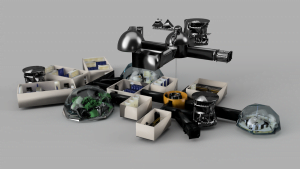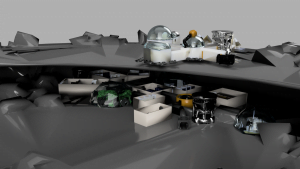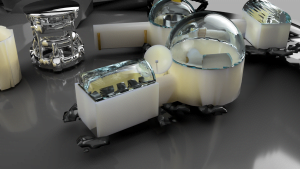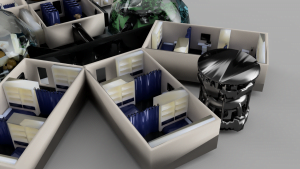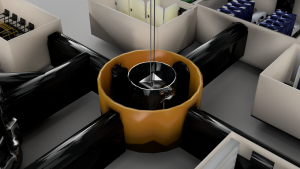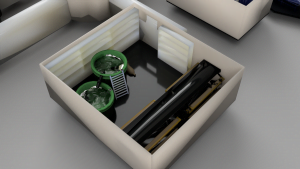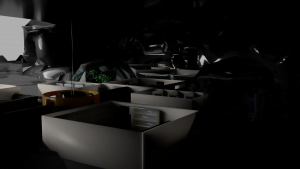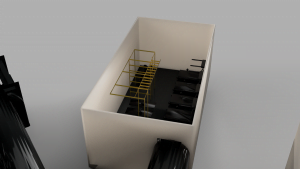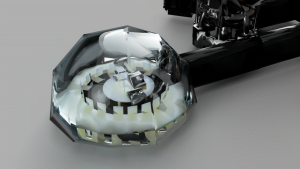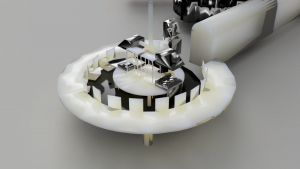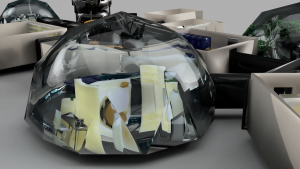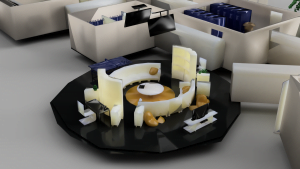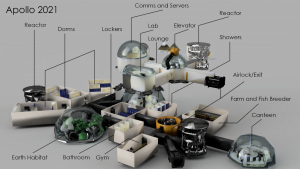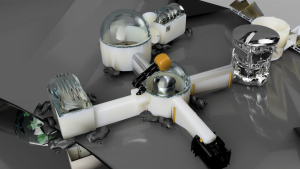Moon Camp Pioneers Gallery 2020-2021
In Moon Camp Pioneers each team’s mission is to 3D design a complete Moon Camp using Fusion 360. They also have to explain how they will use local resources, protect astronauts from the dangerous of space and describe the living and working facilities.
Team: Apollo 2020
I.E.S. Martín Halaja La Carolina (Jaén) Spain 16
External viewer for 3d project
|
Project description
Apollo 2020 has envisioned a permanent base with long term research and scientific missions in mind. We picked the “hole” of the Mairus Hills as our location, we consider it would be the most efficient place to set up a large base due to the caves giving us the ability to protect it from radiation without requiring major terraforming and therefore lowering building costs. We wanted to offer scientists and astronauts a spacious and welcoming living space, as we felt that the inhabitants of the base should feel comfortable whilst performing these previously mentioned long missions, whilst also maximizing use of the space for it all to function efficiently. Apart from the dorms, sanitizing and leisure areas, we equipped the base with a lab to study the area, a communications office to ensure constant contact with HQ on earth, areas to grow food and crops and rounded it all off with several different forms of generating energy to make the base as independent as possible. We also reimagined the functions of a rover to help scientists perform tasks such as mining, rock sample gathering and exploration. This is an innovative project that wants to bring state of the art technology to the moon, providing scientists with everything they need to fulfill countless experiments so we could all learn more about the universe we live in. |
|||
|
Where do you want to build your Moon Camp?
We have decided that the Base should be located at the “Hole”, a lava tube in the Mairus Hills which is estimated to be around 88 meters deep. This hole offers protection against radiation that we would have on earth thanks to our atmosphere, of course that not being the case, the simplest situation was to go underground. We figured that digging out the base from a random crater would be expensive as well as extremely inefficient, so we went with the “Hole” as it is estimated to branch out into the sides, giving us plenty of space to build a base. Apart from that, Marius Hills is characterized by it’s volcanic origins and a base there could help study the Moon’s internal activity. The location of the moon has been hand-picked to ensure the most stable temperatures, The whole base is shielded from the sun’s radiation 24/7 due to its location inside of a cave. How do you plan to build your Moon Camp? Describe the techniques and materials you would use.
The process of construction of the lunar base is complex, however, the main summary is that it is fully modular. Similar to how the ISS was built, whole modules of the base would be transported to the moon from earth making use of reusable rocket technology such as the one proposed by spaceX. The individual modules would then be assembled by astronauts or robots. The assembly would be extremely simple, as the only necessary process is to connect the modules through the airlocks. That is all. Once they are connected and pressurized they work like a single unit. This process would be used to build the entirety of the station except for 4 buildings. The two thermonuclear reactors, the oxygen processing building and the water processor/storage building. These aforementioned structures would be transported as a whole from the earth and later be hooked to the base by astronauts. The lunar base offers a plethora of facilities which make the life of astronauts easier whilst simultaneously providing new grounds for exploration and development. Such facilities include a Gym, as well as organic farm with crop as well as fish. The rover management module is located in the upper part of the base, in the surface, we can see a robotic chain which manages the transportation of the robots. Other modules include a fully equipped kitchen with a living area. Ventilation systems. A metallic elevator and a small indoor living space with trees and water for comfort. The environment on the Moon is very dangerous for the astronauts. Explain how your Moon Camp will protect them.
Building a base underground or in a cave such as the “Hole” would offer protection against the aggressive radiation that astronauts would be subject to on a moon base, as well as that, Explain how your Moon Camp will provide the astronauts with:
|
|||
|
Water
|
Food
|
Electricity
|
Air
|
|
Even if methods such as providing water from earth may be viable, using a local source in the moon is essential. Perhaps humanity’s best bet at the moment is to use heated drills or any kind of thermal extraction to mine the ice water trapped in the poles of the moon. This is what we would use on our base, with drilling equipment attached to the rovers. However, alternative sources may arise as we get to know more about the lunar surface. Perhaps methods such as sifting through shadows of the moon for microscopic ice. |
In the base there is a designated area for both growing food such as potatoes, rich in carbohydrates or lentils which have aminoacids. All waste produced by the astronauts would be turned into compost for the farm. To round up a complete diet, there is a fish breeding contraption designed for doomsday bunkers on earth that simulates the life cycle of fish to produce fresh fish meat without using up too much water and fish food. All of this combined, as well as the replenishing missions sent from earth would be able to feed up to 18 astronauts. |
There are several generators distributed to power the different parts of the base. One powering the exterior sections, being the lab, decompression doors and the rovers, another for the elevator and another for the living areas. The way in which the generators work is by nuclear fusion, combining helium 3 in a closed chamber with Deuterium (Hydrogen isotope). This is what’s called an aneutronic reaction (power is generated without the production of neutrons). The reactor would use the heat produced in this reaction to power a small turbine and create electricity. As a backup, we have the technology to burn hydrogen produced from electrolysis and use it for power production. |
Lunar dust, more commonly known as “Regolite” possess between 40 and 45% of oxygen, this oxygen can be extracted through electrolysis. The salts inside of the regolite are melted as it’s heated at 950C inside of a metallic container. In said container, chlorine-sodium salt is used as an electrolyte. The oxygen leaves the regolite and arrives at an anode where it’s extraction can occur. The oxygen can be used either as rocket fuel or for breathing purposes, other metal alloys which can have a plethora of uses are also produced. |
|
Explain what would be the main purpose of your Moon Camp (for example: commercial, scientific, and/or tourist purposes).
The soul objective of the base is to research the depths of the crater, retrieve samples and rocks and study the geological activity on the moon as it is a volcanic area. Scientists would populate it year-round to try to use the base to its maximum potential and gather as much information on the moon as well as conducting countless experiments in and around the crater. This base could be used as a simulation for low gravity conditions and to test how humans could adapt to a new planet. The “Hole” offers a bunch of different conditions depending on the depth at which an experiment is being conducted and whether it is in contact with the sunlight or not. |
|||
|
Describe a day on the Moon for your Moon Camp astronaut crew.
The base being completely self-sufficient, means that missions taking place in it could span out for months or even a year without the need of a restocking mission to bring resources or food. The missions being so long means that days would be less jam-packed for the astronauts. A day would go as follows: 7am: Start wake-up routine. That’d be, go to the locker room, get the clothes, sanitize at the bathrooms, and check vital base systems, air, water, pressurization and report back to HQ. 8:30am: After everyone is ready there would be a briefing meeting to establish what tasks are going to be performed that day, these can vary between programming the rovers, cleaning the base, a walk around the exterior, taking samples, preparing the food, lab work and overseeing energy and water production. Some of the crew would have the morning off and would be able to go to the leisure area, the gym or the indoor “garden” and pond. 9am: First part of the morning tasks 11:30am: For breakfast, everyone would regroup at the cantine. By then, the part of the crew that had taken care of the food and crops should have the meal ready for everyone to have. 12am Second briefing, the astronauts log what they had done in the first half of the morning and have another briefing for the second part. 12:30am: Second part of the morning tasks 2:30pm: Lunch break for 30 minutes, the meals are prepared by the food crew again.
3:30pm: First part of the afternoon tasks.
5:30pm: After the 2h shift the crew rotates and ensures the work has been done effectively and correctly.
6:30pm. All the crew now heads to the gym for 30 mins, to minimize the effect of microgravity and stay fit
7:00pm. The food crew will prepare dinner and the rest will oversee air production or will submit a small report of the day with earth.
8:00pm. The watch duty crew members rotate, and the rest of the team manage the day’s waste. 8:30pm. Now the crew can use the gym, go to sleep early, read, contact their families or stay at the lounge until lights out. |
|||



